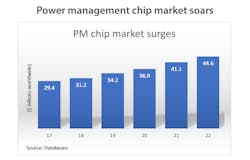Electronics buyers can expect prices for power management semiconductors to remain mostly steady for the next five years, despite growing unit demand and strong revenue growth.
In 2017, the power management chip market grew 13% to about $29.4 billion and will grow 6% in 2018 to $32.2 billion, according to researcher Databeans, based in Reno, Nev. The power management (PM) semiconductor market will have a compound annual growth rate of 9% through 2022 when the market will total $44.6 billion, the researcher said. Power management includes analog ICs such as linear and switching regulators; supervisors; battery management; and voltage references and discretes such as power transistors, rectifiers, and thyristors, according to Databeans.
PM chip revenue is growing because unit demand is rising and prices are mostly flat. Unit shipments are expected to increase 9% per year over the next five years. While demand will continue to be robust, average selling prices will not change much. The average price for a power management chip was $.17 in 2017 and will drop to $.16 in 2018, but remain steady through 2022, according to Susie Inouye, founder and research director of Databeans.
Robust Demand
Demand for power management semiconductors is strong across many end customer segments, including smartphones and other portable electronics equipment; the Internet of Things (IoT), including industrial IoT applications; automotive systems; and computers.
Consumer wearable IoT applications such as Apple Watches and FitBits are helping drive power management chip demand, but the “biggest opportunity for IoT is in industrial,” said Inouye. As more industrial equipment is connected to the Internet, more power management ICs are required.
“In IoT, the evolution of PMICs is demanding the lowest power consumption together with the integration of microprocessor cores and non-volatile memories in a traditional analog-only device to deliver the highest level of flexibility and programmability,” said Giorgio Pedrazzini, product marketing vice president for STMicroelectronics, headquartered in Geneva, Switzerland.
But it’s not just IoT that will drive demand over the next five years. “Automotive has been a key driver of PMIC growth,” noted Matthew Tyler, senior director, strategic marketing of the Analog Solutions group at ON Semiconductor, based in Phoenix. “We also see that demand for wireless network infrastructure is higher than expected both for the LTE platforms, as well as the 5G rollout [which] continues to accelerate ahead of expectations.”
Tyler added that data-heavy applications like automotive advanced driver assistance systems (ADAS) cloud computing and 5G “are driving an increase in demand for multi-phase PMICs and highly efficient power stages.”
Automotive, including electric vehicles, is helping to drive demand for power management and other analog chips for Texas Instruments. “We see high demand and growth in our automotive and industrial businesses,” said David Pace, a systems & applications manager at the company. TI supplies power management chips for electric vehicles, ADAS, infotainment, body and passive safety systems.
While batteries are powering more vehicles, replacing gasoline engines in many cars, “electrical pumps, motors, and generators are rapidly replacing electro-mechanical and hydraulic functions in more conventional automotive systems to achieve fuel efficiency targets and improve performance,” said Pace. The transition to electrical motors pumps and generators is also helping to create more demand for power management semiconductors.
Pedrazzini said the trend toward autonomous vehicles is “pushing the need towards a server on each car,” and will result in greater power management content.
More Complexity, More PMICs
Pedrazzini added demand for power management ICs is also increasing because of the “augmented complexity of semiconductor content in newer consumer/mobile products, Industry 4.0, and automotive vehicle to everything (V2X) communications systems, as well as IoT applications in general.”
The need for more efficiency and integration has resulted in greater demand for power management ICs that “integrate multiple linear and switching voltage regulators and battery management on a single chip,” he said.
By interfacing power management ICs and microcontrollers in a system—and with integration of analog functions such as voltage monitoring, energy harvesting, wireless, and other features—PMICs “offer the highest level of integration, programmability, and flexibility” that in the past was only achievable through expensive and space-consuming discrete circuitry, said Pedrazzini.
PMICs particularly high in demand are multiple output switching regulators with very sophisticated power management algorithms, he added, which improve power density and efficiency. Pedrazzini also noted that some systems require linear regulators to handle noise, precision, and voltage ripple issues.










